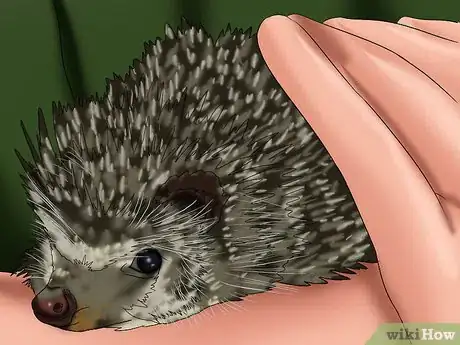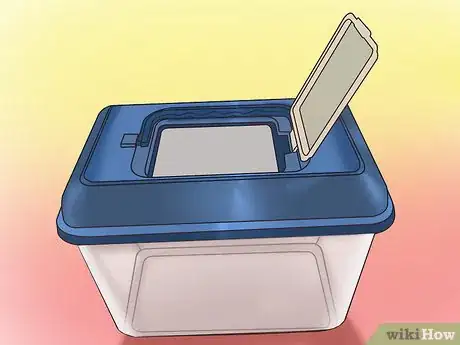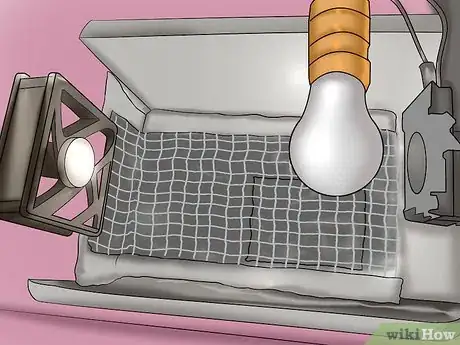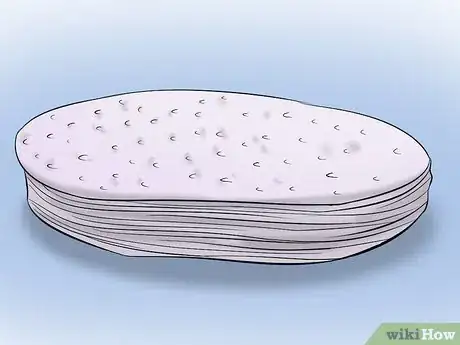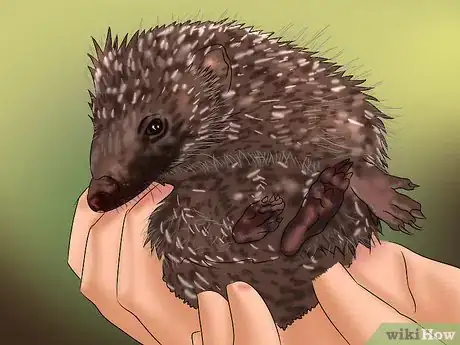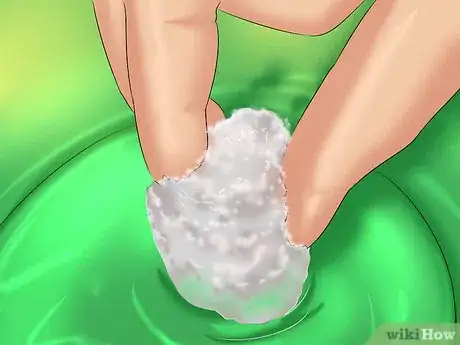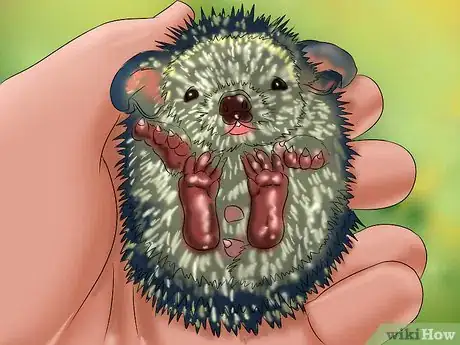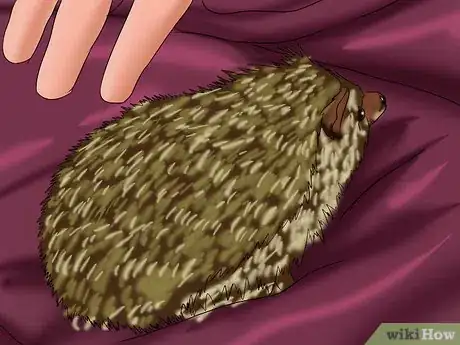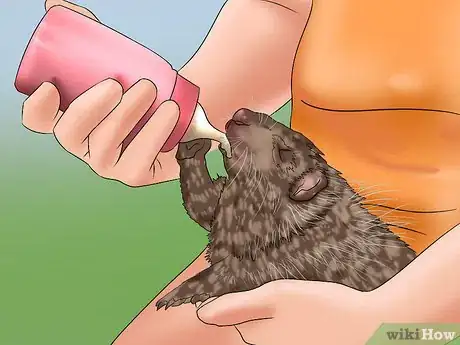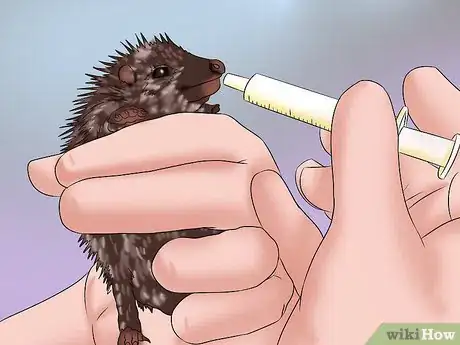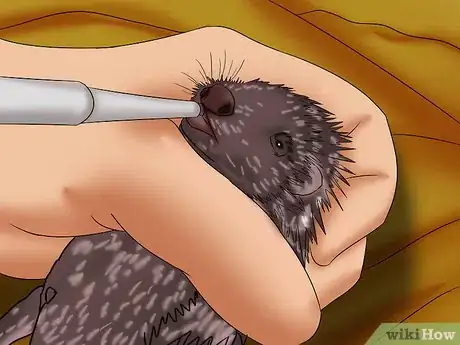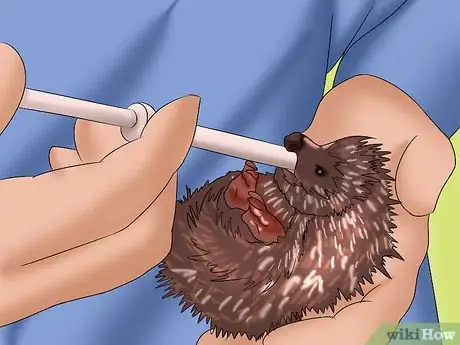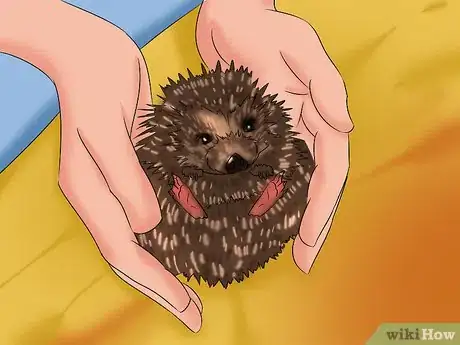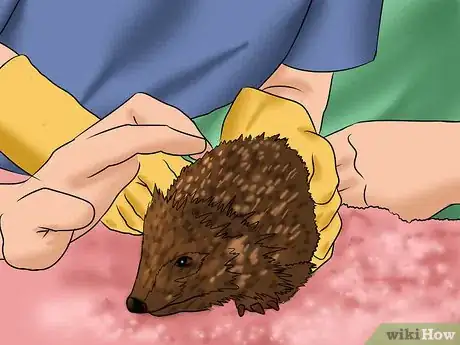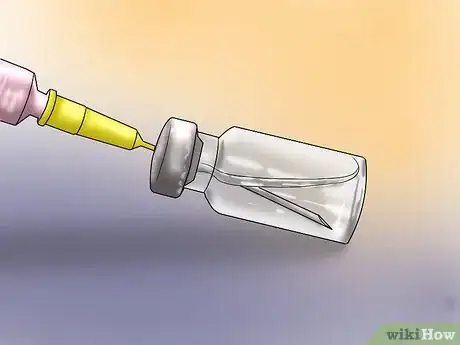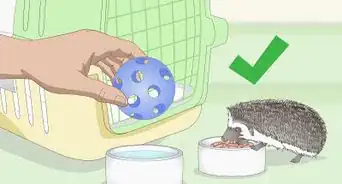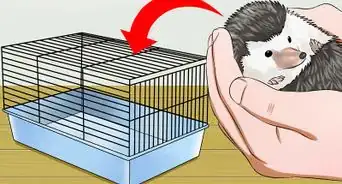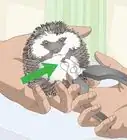This article was co-authored by Pippa Elliott, MRCVS. Dr. Elliott, BVMS, MRCVS is a veterinarian with over 30 years of experience in veterinary surgery and companion animal practice. She graduated from the University of Glasgow in 1987 with a degree in veterinary medicine and surgery. She has worked at the same animal clinic in her hometown for over 20 years.
wikiHow marks an article as reader-approved once it receives enough positive feedback. In this case, 82% of readers who voted found the article helpful, earning it our reader-approved status.
This article has been viewed 32,138 times.
A hedgehog is a spiny mammal with short legs that rolls up into a ball when threatened. In nature, the adults live by foraging in leaf litter for small insects and grubs, and like most mammals, the young are nourished by milk for the first few weeks of life. Very young hedgehogs (from a day or so old) can be hand-reared, although close attention needs to be paid to temperature, hygiene, and feeding.[1]
Steps
Part 1: Warming Up Your Baby Hedgehog
-
1Use a hot water bottle to warm up your hedgehog. Away from its mother, your baby hedgehog is liable to lose heat quickly because of its large surface area. A chilled hedgehog is an inactive hedgehog that will rapidly go into a downward spiral that results in death.
- A healthy hedgehog should feel warm to your touch or slightly warmer than your body temperature.
-
2Fill a hot water bottle with boiled water and wrap it in at least two towels. It’s important to wrap the bottle because direct contact with the heat could burn the hog.Advertisement
-
3Place the hedgehog on the wrapped hot water bottle. Cover it with a small blanket, such as a dry face cloth, folded over, to prevent heat from escaping.
-
4Check how warm the hedgehog feels with your finger. Once it feels slightly warmer than your own skin, transfer it to a box with a heat source.
- Be aware that overheating your hedgehog can cause blood clots to form in its circulation, which is just as dangerous as being too cold.
- Signs of overheating include gaping, or opening its mouth wide in order to lose heat, floppiness when picked up and also feeling hot to the touch.
- Never feed a cold hedgehog since they depend on body warmth to help with digestion.
Part 2: Housing and Toileting Your Baby Hedgehog
-
1Use a small plastic aquarium or a small plastic pet carrying box. These are ideal as they can easily be disinfected and are not flammable.
-
2Set up a heat source above the box to keep the baby warm. A desk lamp is a good compromise, situated so that it shines just above one end of the box.[2]
- Substitute the bulb for a red bulb so that the baby is not constantly blinded by the light. Red bulbs commonly come in 20W, 25W, or 40W ratings.
- Place the heat source at one end of the box, which will allow the baby to move to the cooler end if it gets too hot.
-
3Lay down absorbent bedding in the box that can either be disposed of or washed. A good option is vetbed, which looks like fake sheepskin, and is designed to draw moisture, such as urine, away from the baby so that it doesn't sit on any damp spots.
- An alternative could be shredded newspaper, though keep in mind this could be a fire risk.
-
4Create an area for your hog to hide in. A small cardboard box or the center from a toilet roll, depending on the size of the hedgehog baby, work well. These can also be disposed of and replaced easily when soiled.[3]
-
5Encourage your hedgehog to go to the bathroom by stimulating its bladder. Baby hedgehogs do not empty their bladder and bowels unless stimulated to do so. If you don’t do this, your hedgehog’s bladder will become uncomfortably full and it may develop urine overflow. This means its overfull bladder will spill over with urine, which will then dribble down the outside of its legs and scald its skin, making it more susceptible to a skin infection.
-
6Soak a cotton ball in warm water, and squeeze out the excess water until the cotton ball is just damp. Vigorously wipe the hedgehog's rear end until it urinates or moves its bowels.[4]
- This may take a few minutes.
- Repeat this procedure before and after every feed, as these are the times when it is most likely to go to the bathroom.
Part 3: Handling and Feeding Your Baby Hedgehog
-
1Be sure to handle your hedgehog from an early age. If the hedgehog is orphaned, then start handling it immediately.[5]
-
2Always wash your hands before and after handling your hedgehog. Remember to also keep its bed clean by removing any soiled bedding, and disinfecting its box daily.
-
3Gently stroke it in the direction of its spine. You should also talk to your hog whenever you wipe its bottom or feed it.
- If the baby is still with its mother, handling could cause the dam to reject her baby. So minimize stroking until it spends time in a different part of the bed, away from its mother.
-
4Feed the baby hedgehog with a feeder bottle designed for kittens, such as the Catac system, an eyedropper, or a 1ml syringe. If you are using a feeder bottle make sure it has a soft latex teat attached in the smallest size available.[6]
-
5Disinfect the feeding apparatus after every feed. You can use a steam sterilizer, which is also used to disinfect baby bottles or a liquid sterilizing agent like Milton.[7]
- Milton should be diluted in water.
- Immerse the feeding equipment in the solution for at least half an hour.
- Rinse the equipment well with fresh water prior to use to remove any traces of the sterilizing agent.
-
6Give your baby hedgehog regular feeds of milk. Typically four meals a day is sufficient.
- A suggested routine is an early morning feed, a lunchtime feed, a late afternoon feed, and a bedtime feed.
- Don't forget to wipe your hog’s bottom before and after every feed!
-
7Use goat’s milk to feed an unweaned hedgehog. In an ideal world, you would feed your hedgehog with hedgehog replacement milk, but this is not currently available.[8]
- Cow's milk is a poor substitute for hedgehog milk, but goat's milk is a passable alternative.
-
8Warm the milk by immersing the container in hot water. Be sure to shake the milk regularly to mix it up.
- Your hedgehog is programmed to expect warm milk from its mother, so it will likely refuse cold milk.
- Much like feeding a human baby, warm the milk to just above body temperature and test it by dropping some of the milk onto the back of your hand. If it feels pleasantly warm, the temperature is correct.
-
9Place a drop of milk at the end of the teat on a bottle or an eye dropper. Hold it near the hedgehog’s mouth.
- If it doesn’t smell the milk and take the hint, try touching the drop of milk to its lips. If your hog is hungry, this will usually trigger its suckling reflex.
-
10Let it suckle until its tummy is rounded and full. Once it is satisfied, it may lose interest and become sleepy.[9]
- If the milk flows too quickly from the teat, it will flood its mouth and spill out around its lips. The milk usually flows too quickly if the hole in the teat is too large, in which case, you should start again with a fresh teat and a smaller hole.
Part 4: Weaning and Taking Care of Your Baby Hedgehog
-
1Start to wean the baby hedgehog when it is around 21 days of age. Do this by leaving solid food in its box, which will give it an opportunity to test out the food by itself.
- As it continues to grow and get hungry between milk feeds, the chance of supplementing its calorie intake with some hedgehog friendly morsels will be increasingly appealing to it.
-
2Use suitable foods for weaning. These include Farley's rusk softened in goat's milk, plain digestive biscuits softened with milk, good quality canned puppy food, wild plants such as dandelion, chickweed, or clover, and waxworm larvae or mealworms.[10]
-
3Pay attention to any discharge from your hog’s eyes or nose. Your baby hedgehog should have dry bright eyes, and a clean nose.
-
4Take it to a vet if it does not suckle at feeding time and is breathing rapidly. Greedy hedgehog babies are prone to breathing in milk, which can cause pneumonia and requires treatment with antibiotics.
-
5Worm your hog with fenbendazole when it is about 4-6 weeks old. Fenbendazole is sold as Panacur and the liquid suspension version is the easiest way to administer the wormer.
- This wormer can be gently syringed into the hedgehog's mouth, giving it a chance to swallow each mouthful.[11]
-
6Weigh your hedgehog to determine the right dosage of Panacur. Use a digital scale that is accurate for low weights.
- A kitchen scales will do but line it well with a disposable kitchen towel and disinfect it well after weighing your hog. Hedgehogs can carry some diseases that don't make them sick but could infect people, such as salmonella, so if you are worried about disease, dispose of the scales after weighing your hog.
- The dose of Panacur is 50 mg for every 1 kg of body weight, repeated once a month.
- An average hedgehog weighs between 400-500 g, requiring 20 to 25 mg of Panacur in solution. This is equivalent to 0.2 to 0.25 ml of the 10% solution.[12]
Part 5: Owning Your Hedgehog
-
1Be aware which states consider it illegal to own a hedgehog. Currently, hedgehogs are prohibited animals in Maine, California, Arizona, Pennsylvania, Georgia, and Hawaii - but this list is not exhaustive and changes regularly so always check your state law first before buying a hedgehog.[13]
- Hedgehogs are illegal in some states because some species can transmit the highly infectious Foot and Mouth Disease.
- As well, should the hedgehog escape into the wild, it could pose a theoretical risk to cloven-footed animals (cattle, goats, sheep) and impact local agriculture.
-
2Check with your state’s Fish and Game department if you find a hedgehog. They will be able to tell you whether the hedgehog is legal or illegal and whether you need special permits to keep the hog.[14]
Expert Q&A
-
QuestionMy hedgehog gave birth unexpectedly 3 weeks ago, both babies are alive but one is rather skinny is he going to be okay?
 Pippa Elliott, MRCVSDr. Elliott, BVMS, MRCVS is a veterinarian with over 30 years of experience in veterinary surgery and companion animal practice. She graduated from the University of Glasgow in 1987 with a degree in veterinary medicine and surgery. She has worked at the same animal clinic in her hometown for over 20 years.
Pippa Elliott, MRCVSDr. Elliott, BVMS, MRCVS is a veterinarian with over 30 years of experience in veterinary surgery and companion animal practice. She graduated from the University of Glasgow in 1987 with a degree in veterinary medicine and surgery. She has worked at the same animal clinic in her hometown for over 20 years.
Veterinarian It's difficult to say, but you can help by keeping the babies warm, and making sure the mother feels secure and is eating well.
It's difficult to say, but you can help by keeping the babies warm, and making sure the mother feels secure and is eating well. -
QuestionCan I just use a warm water bottle to warm him up do I have to get a heat lamp?
 Pippa Elliott, MRCVSDr. Elliott, BVMS, MRCVS is a veterinarian with over 30 years of experience in veterinary surgery and companion animal practice. She graduated from the University of Glasgow in 1987 with a degree in veterinary medicine and surgery. She has worked at the same animal clinic in her hometown for over 20 years.
Pippa Elliott, MRCVSDr. Elliott, BVMS, MRCVS is a veterinarian with over 30 years of experience in veterinary surgery and companion animal practice. She graduated from the University of Glasgow in 1987 with a degree in veterinary medicine and surgery. She has worked at the same animal clinic in her hometown for over 20 years.
Veterinarian A hot water bottle wrapped in a towel is fine, but try to provide an area away from the hottie that the hog can move to if they get too hot.
A hot water bottle wrapped in a towel is fine, but try to provide an area away from the hottie that the hog can move to if they get too hot.
References
- ↑ Practical Wildlife Care. Les Stocker. Blackwell Science
- ↑ Practical Wildlife Care. Les Stocker. Blackwell Science
- ↑ Practical Wildlife Care. Les Stocker. Blackwell Science
- ↑ Practical Wildlife Care. Les Stocker. Blackwell Science
- ↑ Practical Wildlife Care. Les Stocker. Blackwell Science
- ↑ Practical Wildlife Care. Les Stocker. Blackwell Science
- ↑ Practical Wildlife Care. Les Stocker. Blackwell Science
- ↑ Practical Wildlife Care. Les Stocker. Blackwell Science
- ↑ Practical Wildlife Care. Les Stocker. Blackwell Science
- ↑ Practical Wildlife Care. Les Stocker. Blackwell Science
- ↑ Practical Wildlife Care. Les Stocker. Blackwell Science
- ↑ Practical Wildlife Care. Les Stocker. Blackwell Science
- ↑ https://www.hedgehogcentral.com/threads/where-hedgehogs-are-illegal.193296/
- ↑ https://www.hedgehogcentral.com/threads/where-hedgehogs-are-illegal.193296/



